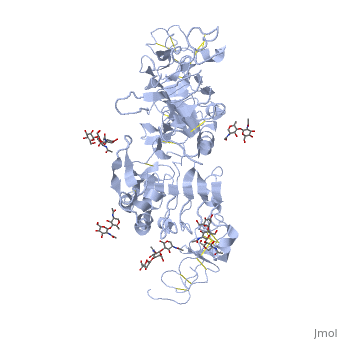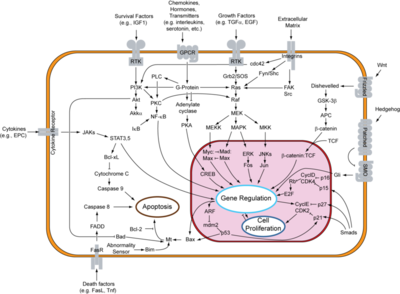Epidermal Growth Factor Receptor
From Proteopedia
(Difference between revisions)
| Line 17: | Line 17: | ||
The binding of epidermal growth factor (EGF) to epidermal growth factor receptor (EGFR) results in the activation of its protein tyrosine kinase activity due to an induced dimerization of the receptor <ref name='sherrill'>pmid 8639530</ref>. This binding of EGF to the EGF receptor is an essential part of the signal transduction pathway that occurs in cells. This binding results eventually in cell division. Problems in this pathway can result in cancerous cells and tumors that eventually can lead to death. Therefore, understanding all parts of signal transduction is essential for understanding the cause of cancer and possible treatments of it. When EGF binds to EGFR, it results in an activation of the receptor which causes a chain of signaling events that leads to cell proliferation. This occurs by transmission of the signal across the plasma membrane because EGFR is a plasma membrane protein and in this sense a transmembrane receptor <ref name='sherrill'/>. Although it is present in normal cells, EGFR is overexpressed in many types of tumor cell lines, and its activation also plays an important role in resistance to chemotherapy and radiation treatment which makes treatment of cancer even more difficult <ref name='herbst'>pmid 15142631</ref>. Since overexpression of EGFR is an attribute of some cancers, it is a plausible idea to find EGFR inhibitors to decrease the activity of EGFR and therefore inhibit cell proliferation and help control the growth of cancer and tumors. EGFR inhibitors have been developed and seem to contribute at times to the regression of tumors <ref name='herbst'/>. | The binding of epidermal growth factor (EGF) to epidermal growth factor receptor (EGFR) results in the activation of its protein tyrosine kinase activity due to an induced dimerization of the receptor <ref name='sherrill'>pmid 8639530</ref>. This binding of EGF to the EGF receptor is an essential part of the signal transduction pathway that occurs in cells. This binding results eventually in cell division. Problems in this pathway can result in cancerous cells and tumors that eventually can lead to death. Therefore, understanding all parts of signal transduction is essential for understanding the cause of cancer and possible treatments of it. When EGF binds to EGFR, it results in an activation of the receptor which causes a chain of signaling events that leads to cell proliferation. This occurs by transmission of the signal across the plasma membrane because EGFR is a plasma membrane protein and in this sense a transmembrane receptor <ref name='sherrill'/>. Although it is present in normal cells, EGFR is overexpressed in many types of tumor cell lines, and its activation also plays an important role in resistance to chemotherapy and radiation treatment which makes treatment of cancer even more difficult <ref name='herbst'>pmid 15142631</ref>. Since overexpression of EGFR is an attribute of some cancers, it is a plausible idea to find EGFR inhibitors to decrease the activity of EGFR and therefore inhibit cell proliferation and help control the growth of cancer and tumors. EGFR inhibitors have been developed and seem to contribute at times to the regression of tumors <ref name='herbst'/>. | ||
| - | ==EGFR and Lung Cancers of "Never Smokers== | + | ==EGFR and Lung Cancers of "Never Smokers"== |
Tyrosine kinases in general control critical cellular activities through regulation of signal pathways <ref name='pao'>pmid 15329413</ref>. This regulation is essential for controlling the cell and making sure it acts normally and goes through the normal cell cycle. However, when these kinases are mutated, they can lead to cancer as a result <ref name='pao'/>. Mutations in EGFR as a result can also lead to cancers, and this is why understanding how EGFR works is an essential aspect for the treatment of certain cancers. In cancer, cells divide rapidly without control and an uncontrolled or unregulated EGF receptor will and can result in uncontrolled cell division. Therefore, inhibition of EGFR can be an essential part of controlling cancers caused by mutations in EGFR. | Tyrosine kinases in general control critical cellular activities through regulation of signal pathways <ref name='pao'>pmid 15329413</ref>. This regulation is essential for controlling the cell and making sure it acts normally and goes through the normal cell cycle. However, when these kinases are mutated, they can lead to cancer as a result <ref name='pao'/>. Mutations in EGFR as a result can also lead to cancers, and this is why understanding how EGFR works is an essential aspect for the treatment of certain cancers. In cancer, cells divide rapidly without control and an uncontrolled or unregulated EGF receptor will and can result in uncontrolled cell division. Therefore, inhibition of EGFR can be an essential part of controlling cancers caused by mutations in EGFR. | ||
| Line 30: | Line 30: | ||
EGFR inhibitors used in breast cancer treatment<br /> | EGFR inhibitors used in breast cancer treatment<br /> | ||
| - | * [[Lapatinib]] | + | * [[Lapatinib]] or Tykerb<br /> |
EGFR inhibitors used in pancreatic and small cell lung cancer treatment<br /> | EGFR inhibitors used in pancreatic and small cell lung cancer treatment<br /> | ||
| - | * [[Gefitinib]] | + | * [[Gefitinib]] or Iressa<br /> |
| - | * [[Erlotinib]] | + | * [[Erlotinib]] or Tarceva<br /> |
EGFR inhibitors used in renal cell carcinoma and kidney cancer treatment<br /> | EGFR inhibitors used in renal cell carcinoma and kidney cancer treatment<br /> | ||
| - | * [[Sorafenib]] | + | * [[Sorafenib]] or Nexavar<br /> |
EGFR inhibitors used in renal cell carcinoma and gastrointestinal cancer treatment<br /> | EGFR inhibitors used in renal cell carcinoma and gastrointestinal cancer treatment<br /> | ||
| - | * [[Sunitinib]] | + | * [[Sunitinib]] or Sutent<br /> |
* See also [[Journal:JBSD:35|A Possible Strategy against Head and Neck Cancer: ''In Silico''. Investigation of Three-in-One inhibitors]] | * See also [[Journal:JBSD:35|A Possible Strategy against Head and Neck Cancer: ''In Silico''. Investigation of Three-in-One inhibitors]] | ||
== 3D Structures of Epidermal Growth Factor Receptor == | == 3D Structures of Epidermal Growth Factor Receptor == | ||
Revision as of 12:10, 10 October 2023
| |||||||||||
Additional Resources
For additional information, see: Cancer
References
- ↑ D'Uva G, Aharonov A, Lauriola M, Kain D, Yahalom-Ronen Y, Carvalho S, Weisinger K, Bassat E, Rajchman D, Yifa O, Lysenko M, Konfino T, Hegesh J, Brenner O, Neeman M, Yarden Y, Leor J, Sarig R, Harvey RP, Tzahor E. ERBB2 triggers mammalian heart regeneration by promoting cardiomyocyte dedifferentiation and proliferation. Nat Cell Biol. 2015 May;17(5):627-38. doi: 10.1038/ncb3149. Epub 2015 Apr 6. PMID:25848746 doi:http://dx.doi.org/10.1038/ncb3149
- ↑ 2.0 2.1 Sherrill JM, Kyte J. Activation of epidermal growth factor receptor by epidermal growth factor. Biochemistry. 1996 May 7;35(18):5705-18. doi: 10.1021/bi9602268. PMID:8639530 doi:http://dx.doi.org/10.1021/bi9602268
- ↑ 3.0 3.1 Herbst RS. Review of epidermal growth factor receptor biology. Int J Radiat Oncol Biol Phys. 2004;59(2 Suppl):21-6. doi:, 10.1016/j.ijrobp.2003.11.041. PMID:15142631 doi:http://dx.doi.org/10.1016/j.ijrobp.2003.11.041
- ↑ 4.00 4.01 4.02 4.03 4.04 4.05 4.06 4.07 4.08 4.09 4.10 Pao W, Miller V, Zakowski M, Doherty J, Politi K, Sarkaria I, Singh B, Heelan R, Rusch V, Fulton L, Mardis E, Kupfer D, Wilson R, Kris M, Varmus H. EGF receptor gene mutations are common in lung cancers from "never smokers" and are associated with sensitivity of tumors to gefitinib and erlotinib. Proc Natl Acad Sci U S A. 2004 Sep 7;101(36):13306-11. doi:, 10.1073/pnas.0405220101. Epub 2004 Aug 25. PMID:15329413 doi:http://dx.doi.org/10.1073/pnas.0405220101
Proteopedia Page Contributors and Editors (what is this?)
Michal Harel, David Canner, Alexander Berchansky, Joel L. Sussman, Jaime Prilusky


